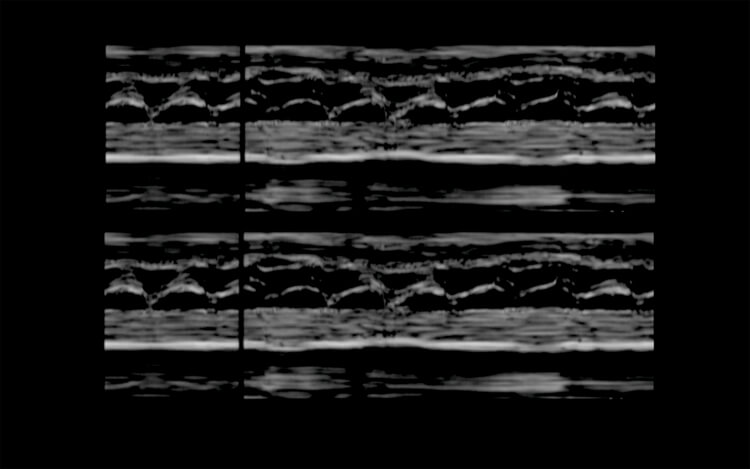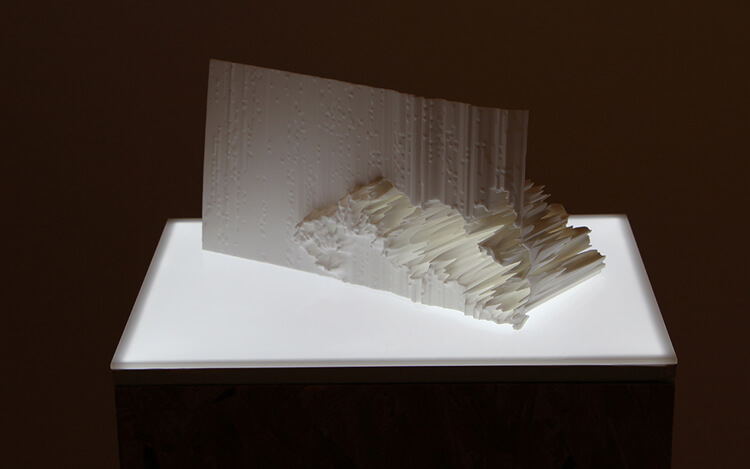Words by Henry Broome

I’m always trying to challenge the fixed point of view, its security and the political, military and techno-scientific systems that uphold the privilege of that viewpoint, says artist Katy Connor. Her work questions the certainty of scientific rationale. It reveals a type of experience that can’t necessarily be measured but perhaps only felt, which in the interview below, Connor terms “pre-logical states of intuition”.
In 2011 the artist began working with Atomic Force Microscopy (AFM), a device ordinarily used in biomedicine. A small probe with an acutely sharp tip scans across a sample, recording variations in the matter on a nanoscale. The information is then fed into a computer, which generates a map of the sample’s topography. Connor employed AFM to analyse her own blood, using the resultant data to make a series of works called Untitled_Force (2011-2015).
The blood sample produced a vast amount of data, so much so the artist recalls When I was working at Exeter University, the lab scientists were just like, ‘We can’t work with this data. It’s enormous. It’s making our machines crash! In this sense, the work creates what Connor calls a “vertiginous threshold”, a sublime but deeply unsettling contrast between the infinitesimally small and unfathomably large.
As the series developed, Connor rendered the scans in plastic using a 3-D printer. The jagged white sculptures look like giant ice fields, probably like the ones Connor encountered on her 2015 Arctic residency. For the artist, the objects conjure a Romantic sense of a sublime landscape painting, like Caspar David Friedrich’s painting Das Eismeer [The Sea of Ice (1823/1824)], again causing a flux between the little and large, here between an expansive landscape and a drop of the artist’s blood.
You might say, Untitled_Force is made from the body, but – because the body acts as the measure and means by which vast shifts in scale and location occur – the work produces an unnerving feeling of disembodiment, of dissociation. It’s closely related to PURE FLOW 2.0 (2011), a mobile app, which transforms Global Positioning Systems (GPS) into a technology of disorientation.
The app reveals the invisible streams of data travelling between satellites and GPS devices, translating signal fluctuations into a cacophony of white noise and wavy monochrome patterns. A technology that ordinarily provides pinpoint positioning here generates useless abstraction; fixity and reassurance are exchanged for instability and confusion.
The app also works to highlight the growing ubiquity of GPS, particularly since it was incorporated in smartphones. GPS seems entirely absent until we accept requests to transmit our phones’ location but PURE FLOW 2.0 reveals its signals are always present whether we will it or not; they’re just invisible to the eye. With the app, what is always there but otherwise imperceptible is rendered audible and visible, showing that, like many other powerful techno-scientific systems, GPS functions outside our loci of control.

How has your work and research on microscopy and blood developed?
For the first project Untitled_Force, I made a series of works stemming from data from a sample of my blood under an Atomic Force Microscope (AFM). I made a series of sculptures from the data, which were sintered in a plastic called Nylon 12 using a 3-D printer. I was thinking about the body as data – a kind of synthetic body. Nylon-12 is a key ingredient in many cosmetic products.
Research has recently been published that discovers traces of these plastics throughout the world’s water supplies. I considered this material a pollutant of exterior geographies and the body, an interior landscape that’s becoming plasticised. The body becomes this otherly inhuman space through its relationship with the machinic.
I’m now involved in a project called Blood Culture as part of my artist residency at the University of Bristol. It’s a collaboration between myself, and biochemist Dr Ash Toye, who heads up a lab developing immortal red blood cells for eventual use in blood transfusion, potentially replacing human donation.
Then there’s Professor Julie Kent, who’s a sociologist approaching medical technologies from a feminist standpoint; finally, Dr Maria Fannin, who is a human geographer interested in ideas of interior landscapes. For the last six months, I’ve been thinking about the body in relation to the relatively new history of cell culture, responding to the process of tissue engineering and exploring the idea of the body as a kind of construct.
For the work I produced for the project showcase, I recontextualised some of the microscopy images onto old black-and-white TV monitors, exploring the relationship between types of biological and media transmission and ideas of media archaeology. Cell culture dates from the 1950s – the HeLa cells were the first immortal cell line – so exhibiting these vintages, slightly ‘50s monitors seemed very fitting.
I was trying to reposition the relationship between biology and consumer technology. We’re not necessarily used to thinking about the history of cell culture in terms of consumerism and domesticity. But lab culture has enormous impacts on what we think of as the every day of our lived experience, particularly women’s bodies.
Could you expand on what you described above?
There’s a history of instrumental use of women’s bodies by biotech and industry, which Donna Haraway writes about in her Cyborg Manifesto (1984). Haraway talks about “the informatics of domination”: a situation in which women’s bodies are intimately restructured through science and technology.
These are ideas I’d like to develop further – especially in relation to the micro-controlling of environments and the implicit aims of blood engineering. I’m particularly interested in attempts to produce synthetic hormones in order to suppress menstruation. This points to a very specific idea of what bodies ought to be: a ‘clean’ and highly controlled body, ‘free’ from volatility and the horror of objection.
You seem to be challenging science’s supposed neutrality.
Absolutely, I’ve found through the residency that lab practice is much more intuitive than a strictly objective method. For example, people working in the lab have gone from small-scale production to writing the protocol to manufacture on a much larger scale.
Still, they can’t apply this protocol in the lab because every single donation of blood from each donor is slightly different. It becomes a case of making allowances, allowing things to grow for an extra few days. I’m very interested in teasing these less instrumental methods out, which in my mind, is very much more a poetic approach; I think that’s incredibly important.
You spoke of challenging scientific rationale by exploring “pre-logical states of intuition” and notions of the sublime. How do these ideas relate to your residency in the Arctic in 2015 and your work with AFM?
What was surprising about Untitled_Force was the amount of data this tiny scan of blood generated. When I was working at Exeter University, the lab scientists were just like, “We can’t work with this data; it’s enormous; it’s making our machines crash!”
The dataset revealed a complex, remote geography; I was intrigued by how this could operate as a metaphor for the body as an undisclosed site that cannot easily be grasped but can perhaps be felt. Looking at the 3-D typography of the data in the modelling software and into the 3-D print machines, I got this Romantic sense of a sublime landscape painting, as Caspar David Friedrich’s painting Das Eismeer, which depicts a ship caught up in these huge glacial ice flows.
I found I was peering into a miniature Arctic scene, like the ones I saw during my residency there. These scale shifts are important because they can’t be ordinarily grasped through rational logic. I’ve often felt drawn to the relationship between the micro and the macro, and there’s a vertiginous threshold, a precariousness between these spaces. I’m always trying to challenge the fixed point of view, its security and the political, military and techno-scientific systems that uphold the privilege of that viewpoint.
How does this sense of vertigo play out in your video work?
In an earlier video installation, I was interested in creating a disorienting event space where the audience experiences a moment of instability through a shifting relationship between body and image. I exhibited Afterglow (2007) in a solo show in Exeter in 2009 (Exeter Phoenix).
The projection filled the wall of a tiny room, which was completely dark. The film cuts between interior views – microscopy and ultrasound – and shots of Birmingham city at night, which were filmed from a helicopter using a long telephoto lens and a gyroscopic camera head. In that dark, small space, where the viewer is almost pressed directly up against the screen, there’s a feeling of falling into the image.
How does the app you exhibited at TRANSMEDIALE 2013, Pure Flow 2.0, simultaneously orientate and disorientate the user?
Before making the work, I became very aware of how people used Sat-Navs and smartphones linked to GPS. People seemed more orientated by the screen that they were looking at than their immediate environment. We are losing the skills of orientation. Where you might have read a map or intuited your way through an environment, we rely on GPS, creating some very precarious situations.
I took a short residency in 2013, where I went to the Scottish Highlands, to a place called Outlandia. If you look at Google Maps on a screen, the landscape there is entirely flat, but walking around, the mountains are absolutely enormous.
The authorities have now put up signs saying, “Don’t climb Ben Nevis just using the GPS on your phone” because it can lead you off the edge of a cliff! GPS is an inherently fragile system; the communication signal is very weak and can be affected by atmospheric weather, electromagnetic storms and certain urban environments. Here, a system is primarily used for assurance of coordination and control but is so unstable by its very nature.
Pure Flow destabilises GPS, which is, in essence, a surveillance system. Are you trying to check science and technology’s power to intrude, control and coerce?
Yes, on a very fundamental level! We’re designing micro-controlling environments from a social level all the way down to cellular and nano-scales. Big-data companies like Cambridge Analytica, which are politically motivated to find out people’s voting habits and swing elections, are absolutely abhorrent.
In terms of my practice, I feel limited in what I can personally do because unless you’re an expert coder or hacker, possibilities of intervention are limited, other than being socially and intellectually informed.
Within my work, I’m interested in unpicking histories of technologies. I think it’s really important to know where these technologies have come from and the purposes for which they’ve been designed. GPS comes from a history of Cold War missile guidance technology that was then domesticated in the ‘90s with consumer electronics.
I found that the practice of culturing synthetic blood in the lab comes from a request from DARPA, the US Defence Advanced Research Projects Agency, to develop synthetic blood for American forces in the field. I try to unpick these associations and reposition these technologies so there’s not a single given form in which they’re presented.
What is your chief enemy of creativity?
Not having independence. Like in Virginia Woolf’s A Room of One’s Own (1929), it’s not having time and space of one’s own – not necessarily a studio, but headspace.
You couldn’t live without…
My son.






